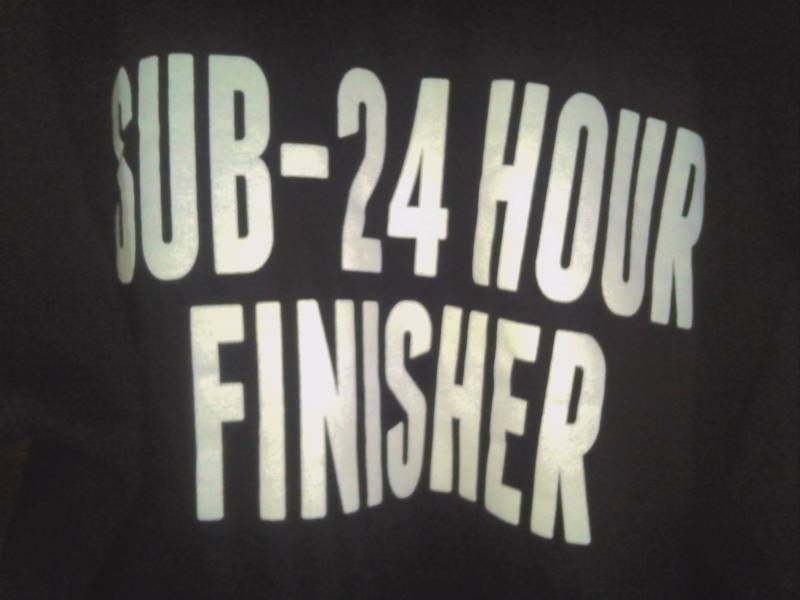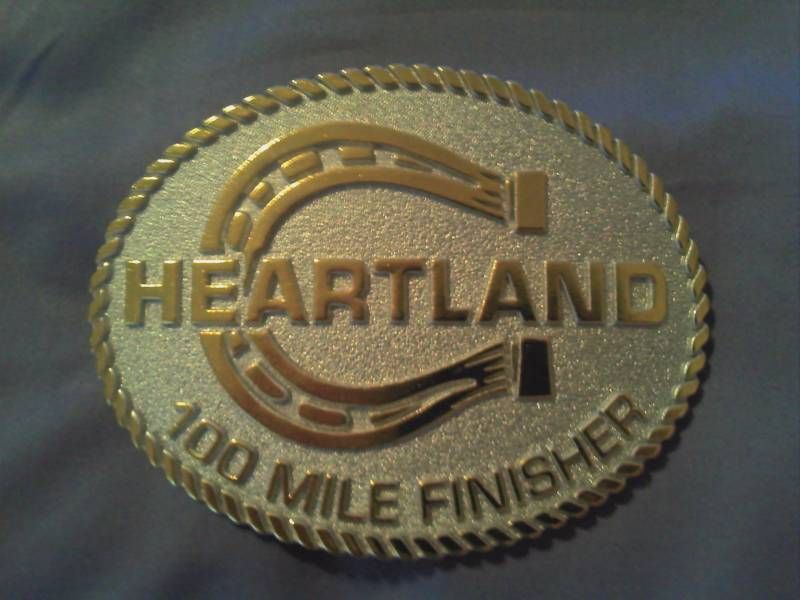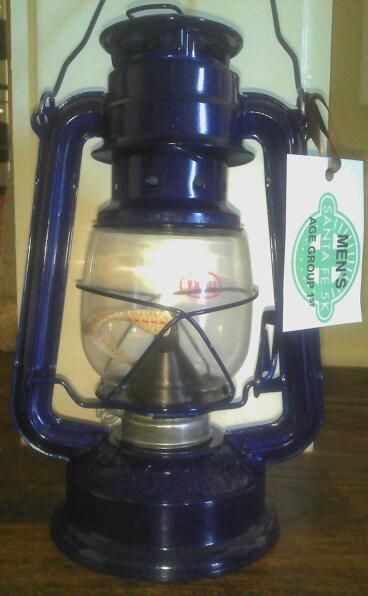I finished my first 100-mile race on my third attempt, getting back to where I started after 23 hours, 12 minutes, 36 seconds.
DID YOU WIN?
DID YOU READ WHAT I JUST WROTE? Yes, I won by finishing. Coming in under 24 hours was a sweet bonus. Officially I was 22nd out of 89 starters. There were 61 finishers, 27 of whom went under 24:00.
HOW'D THAT HAPPEN?
After my DNF at Old Dominion in June, I returned home to stew. I was mopey in the immediate aftermath, but after a few days a feeling of revenge set in, and by the following weekend I had registered for Heartland. I decided that after posting 2 DNFs in 100s, I would keep this one to myself (and somewhat incredibly, other than my wife only 1 other person found out I was running). If I finished, it'd be a great surprise for everyone. If I didn't, well, then it never happened.
I pulled into the little town of Cassoday, Kansas just a few minutes before the start of Friday afternoon's pre-race briefing. There was a threat of severe weather looming ahead the next day, although race officials were optimistic that we would miss the worst of it. I treated myself to a hearty spread of brisket, potato salad and various other sides before driving back to the hotel in El Dorado, 20 miles away (Cassoday has no hotels).
I slept better than I thought I would and headed out the door at 4:30. The race started at 6:00 under clouds but no rain. Only needing light for an hour or so, I had packed my headlamp for Matfield Green (mile 42.5/57.5) and would start with just a flashlight, dropping it at the first aid station (Battle Creek, 8.2). I consulted the 24-hour pace chart in my pocket; I was way ahead, but this was by design because I used even splits, allowing me to "bank" time for the inevitable late-night death march.
The next section provided a good 4 miles of somewhat sharply rolling hills, wet enough from the previous day's rain to make for really sticky mud that glommed onto my shoes at the least opportune times (such as on one particular downhill when it seemed as though the sudden addition of weight to my feet would send me tumbling). Shortly after that, the first round of storms moved in, earlier than I was expecting. My pace quickened. Given that I'd be running through the prairie, I had read about lightning strikes and determined that of the two outcomes of being hit, survival was probably the lesser preferred. I wasn't feeling lucky.
At the Lapland aid station (16.8), I asked for a weather update. They told me it would be bad for another half hour. Sure enough, about a mile out of the aid station, just as I was nearing the top of a significant hill, the count between the flash and the boom narrowed to 2 beats. Funtime was over. I made it to a tree alongside the road and crouched down (I think there was a power line there also, so I shouldn't have been the most attractive object to lightning). I let about 5 minutes go by without any more close calls, then got up and continued.
I got to the Teterville Road aid station (25) in 4:12, putting me even further ahead of schedule. This was a good thing, because just after that aid station was another pretty long stretch of squishy mud. With the course being just straightforward out-and-back, I'd be seeing everything again, probably in worse shape if it kept raining. Slopping through mud in the dark, I'd better have some extra time to work with.
At Texaco Hill (31.2) I changed socks for the first time. My feet were in decent shape -- they clearly looked as though they'd been wet for hours, but there was no maceration and I didn't have any real hot spots. I coated all the areas I usually have trouble with lube and slipped on a nice dry pair of socks... which stayed dry for what seemed like mere moments. The rain would continue to come in waves for a few more hours. In between, the wind would whip along strong enough to pretty much dry me back off.
My first stop at Matfield Green was the point where I needed to decide whether I'd be back before it got dark or I'd need to take my headlamp with me. My pace chart was pretty much destroyed by now (note to self: next time, laminate it!) but I knew without looking that I had plenty of time, since I was still adding to my cushion. I hit the turnaround in a rather astounding 9:19, more than 45 minutes faster than I'd run 50 miles before.
Going sub-24 now seemed like a slam dunk, but I kept my focus solely on getting from aid station to aid station. There was still plenty of time for something catastrophic to happen, and I was being told the worst weather of the day was still to come.
Feeling a hot spot develop on my right foot, I changed socks again at Matfield Green. Leaving the aid station, my stomach sank as the middle of my right arch now felt completely raw. I hadn't noticed anything out of the ordinary when I was slathering on more Aquaphor, but this felt really bad. I pushed ahead -- and to my surprise, the feeling went away. Of all the bizarre explanations, it seemed that the Feetures socks I had been wearing had left their signature support pattern etched into the bottom of my foot. When I switched back into Ijinjis, the foot felt raw until the skin smoothed itself back out. (Definitely a useful piece of data for future planning.)
On the way back through the Ridgeline aid station (63.5), I got the good news: The awful storm that had been pointed right at us had veered away and we should be in the clear the rest of the way. By the time I got back to Texaco Hill (68.8), my headlamp was on and I was walking much more than I was running, but I was still in pretty good spirits. I was even happier to realize that I'd kind of forgotten where I was, and the long muddy stretch I was expecting was already behind me (and not all that muddy anymore) when I turned for the next aid station.
At Teterville Road (75) I started to encounter the 50 milers who were turning around and heading back. They were pretty easily sailing past me, since they were toward the lead of their race, but it was still good to have a little more human contact as we approached midnight. At Lapland (83.2) I finally changed out of my sleeveless top into a compression base layer and long-sleeve tech shirt. The wind, which I had expected to die down after sundown, was just relentless and quite possibly even stronger than it had been during the day. But I had a jacket waiting for me at Battle Creek (91.8) to get me through the final stretch, so I was well prepared.
Someone at Lapland asked if this was my first 100 as I sat down to inhale some hot ramen. I said it would be the first I would finish, and they gave their enthusiastic agreement. I had 6 hours to cover 16.8 miles and get in under 24 hours. Really, I was thinking I had 4 hours to get in under 22. But my energy was really fading and my muscles were not holding up. I just trudged ahead toward the finish.
At Battle Creek I sat down for more ramen and to put on my jacket. But wait... no jacket. No, I had in fact packed it for Lapland and completely ignored it while I was changing shirts. I was chattering pretty hard and the hot broth wasn't doing it for me. One of the volunteers went to her car and brought me a spare windshirt and gloves, and I was on my way for the final march to the finish. I waved 22 hours good-bye, and 23 as well, but I didn't care about any of that as I made the last right turn back onto the blacktop and strolled proudly across the finish line.
WHAT ELSE?
Just some random thoughts that will hopefully be useful to someone who wants to run this:
- Tony Clark and Kyle Amos, the race directors, had a pre-race motivational message that really struck a chord with me. They're positive guys, but there's a strong anti-whiner undercurrent that resonates with me. I don't know about Kyle, but Tony is a former Marine who has seen enough to be less than interested in your sob story about dropping out of a footrace because you couldn't take any more. I don't take a crew, I don't have pacers, I don't run for Jesus or Santa or some friend or family member who died too soon; I am out there solely to see what I'm capable of. And I know that as with running any other distance, you get out of this exactly what you put into it, and that's the attitude Tony and Kyle convey. If you do the work, they are your biggest fans. Respecting the distance and developing the mental strength to get through the low points were a couple of difficult assignments Old Dominion dealt me. I think I did my homework.
- There's a certain genius to the course design, specifically with regard to crew access (for those who happen to take one). Crews are not allowed at Battle Creek, so Lapland is the last place to get support. Barring something freakish, if you leave Lapland, you're going to finish the race, since the only other option is to give up at Battle Creek and catch a ride back to the start with an aid station worker -- who won't be leaving until the last runner passes and the aid station is broken down. If you're going to wait several hours for that to happen, you might as well keep going.
- Actually, something freakish did happen in that at least one runner missed the first turn after Lapland and did not finish. I'm not sure how this happened since all turns were quite well marked (and you saw them earlier in the day). The only point of real concern for me was on the way back, after the Texaco Hill aid station. There's a kind of shortcut from one road to another across a field that isn't much more than a mowed swath with a couple of tire tracks. I found the turn, marked by glowsticks, but couldn't find the path and ended up wandering in the tall grass for a couple minutes. Other than that, you really can't get lost.
- You can see the course up to the first aid station on Google Street View. The pictures were actually taken during this race in 2007 (check out the street view for 37.999676,-96.514362; the aid station tents are a little more durable this time around).
- I wore trail shoes with rock plates and gaiters. Depending on your cushioning, you might get away with road shoes -- the course is 99.5% gravel/dirt road -- but there are some sections in the middle that are pretty nasty rocky (these are the Flint Hills after all). Gaiters, though, are not really optional. Without them you will absolutely get all manner of annoying pebbles in your shoes.
- I have got to figure out a better nutrition plan. As with my other long races, I started strong, keeping a steady stream of calories flowing in (250-300 per hour). I tried mixing up Honey Stinger waffles, Gus and various chomps so I was getting different flavors and textures and not getting sick of any one thing. But as with my other long races, I reached a point where I just didn't want to eat anything else. I have to think my epic slowdown can't be blamed entirely on fatigue; I have to keep pumping calories in even when I don't want them. Maybe I need to mix in some candy bars; if I can't manage a Snickers bar no matter what kind of state I'm in, there's something wrong with me. Or maybe I need to turn to liquids late in races. I don't feel like taking "real" food at aid stations is the answer because none of it sounds appetizing to me in the context of running; I don't want to head back out with a full stomach of solid food.
SPLITS?
1st 25 mi: 4:12:11 (10:05 pace)
2nd 25 mi: 5:06:49 (12:16 pace; 9:19:00/11:11 total)
3rd 25 mi: 6:16:48 (15:09 pace; 15:35:48/12:29 total)
4th 25 mi: 7:36:48 (18:16 pace; 23:12:36/13:56 total)
OK, WHAT ABOUT THE REAL REASON WE ALL RUN, THE STUFF?
It's a 100; you get a shirt. If you finish in 30 hours, you get a hoodie that says FINISHER on the back. If you finish in 24 hours, your hoodie has a few extra words:
And of course, there's this:
DRC Half, Nov. 4.


